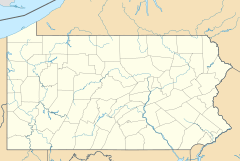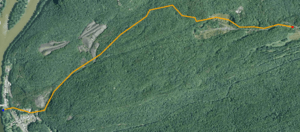Black Creek (Susquehanna River tributary) facts for kids
Quick facts for kids Black Creek |
|
|---|---|
| Physical characteristics | |
| Main source | valley in Conyngham Township, Luzerne County, Pennsylvania between 840 and 860 feet (260 and 260 m) |
| River mouth | Susquehanna River in Mocanaqua, in Conyngham Township, Luzerne County, Pennsylvania 482 ft (147 m) 41°08′42″N 76°08′43″W / 41.1450°N 76.1453°W |
| Length | 2.6 mi (4.2 km) |
| Basin features | |
| Progression | Susquehanna River → Chesapeake Bay |
| Basin size | 3.85 sq mi (10.0 km2) |
Black Creek is a small stream that flows into the Susquehanna River in Luzerne County, Pennsylvania. It is about 2.6 miles (4.2 km) long. The creek runs through Conyngham Township. The land area that drains into Black Creek, called its watershed, is about 3.85 square miles (9.97 km²).
Black Creek is special because it's known as a "Coldwater Fishery" and a "Migratory Fishery". This means it's a good place for certain types of fish to live and travel. But here's a cool fact: Black Creek is an "ephemeral" stream. This means it sometimes disappears! Its water often flows into old underground mines. Because of the mining history in the area, the water can contain different minerals. The region around the creek usually has mild weather. You can usually reach Black Creek by U.S. Route 11, Pennsylvania Route 239, and other local roads.
The Black Creek area is part of the Northern Anthracite Coal Field. This means there are many rock layers and coal beds underground. People started mining coal here as early as 1836. However, all mining stopped by 1955. In the 1960s, several government groups studied the creek and its surroundings.
Contents
Where Does Black Creek Flow?
Black Creek starts in a valley in Conyngham Township. It flows west-northwest for almost a mile. Along the way, it passes through a large pond or a small lake. Then, it turns north for a short distance.
After that, the creek turns west again for a bit. It then enters a wider, shallower valley. Here, another small stream joins it from the right side. Black Creek then turns southwest for over a mile. Finally, it flows south-southwest through a deep, narrow valley. This leads it to the northern edge of Mocanaqua. The creek then turns west for a short distance, following Mocanaqua's border. It eventually meets the Susquehanna River there.
Black Creek joins the Susquehanna River about 171.90 miles (276.64 km) upstream from where the Susquehanna River flows into the ocean.
Are There Any Smaller Streams Joining Black Creek?
Black Creek does not have any officially named smaller streams, called tributaries. However, an old book from 1887 mentioned two streams that joined it. One was unnamed. It flowed from an area west of a place called DuPont Drift. This stream met Black Creek at the Golden Drift.
The other stream was called Turkey Pond Creek. This creek was sometimes almost dry. But it could have a lot of water during spring rains.
Why Does Black Creek Sometimes Disappear?
Black Creek is an ephemeral stream. This means its water flow changes a lot. It used to drain a larger area. But now, its water often disappears into underground mines. This happens because the bedrock (the solid rock beneath the soil) is broken. The creek's path is also disturbed by old strip mines and piles of rocks. The water in Black Creek is often acidic.
The water in Black Creek's area contains different natural chemicals. For example, you can find sulfate and bicarbonate. In some mine waters nearby, there can be high levels of aluminum. Manganese and calcium are also found in the groundwater. Magnesium is present too, especially in polluted groundwater.
Other elements like sodium and potassium are in the water. Sodium is more common than potassium. Small amounts of lithium and rubidium have also been seen. Barium, beryllium, and strontium are also present. Strontium is much more common than the other two.
Very small amounts of titanium, zirconium, vanadium, chromium, and molybdenum are in the water. Cobalt and nickel are found in mine waters. Copper, silver, tin, and lead also occur in the area. The amount of chloride in the water varies.
What is the Weather Like Near Black Creek?
A report from 1971 described the climate near Black Creek as "mild". It rarely gets hotter than 100°F (38°C). However, temperatures below 32°F (0°C) are common. In a nearby town, the highest temperature recorded between 1945 and 1966 was 101°F (38°C). The lowest was -15°F (-26°C). Frosts that can harm plants have been recorded as early as October and as late as May.
What Does the Land Look Like Around Black Creek?
The land around the mouth of Black Creek is about 482 feet (147 meters) above sea level. Where the creek starts, the elevation is between 840 and 860 feet (256 and 262 meters) above sea level. The lowest parts of the watershed are about 500 feet (152 meters) above sea level. These are near the Susquehanna River.
The highest part of the watershed is a ridge in the north. This area is about 1275 feet (389 meters) above sea level. The biggest difference in height across the watershed is 775 feet (236 meters). Locally, the height difference can be up to 740 feet (226 meters). But it is usually less than 500 feet (152 meters).
The Black Creek watershed is at the southwest end of the Northern Anthracite Coal Field. This area has many complex folds and faults in the rocks. The watershed is also part of a valley that was filled in before the last ice age. It contains three coal basins: the West Basin, the East Basin, and the Priscilla Lee Basin. A tunnel connects the West Basin and the East Basin.
There are many pits in the Black Creek area. Some are up to 100 feet (30 meters) deep. Some are old mine entrances, while others are from strip mining. There is standing water in the underground mine workings nearby. The creek once flowed over a rock ledge about 2000 feet (610 meters) upstream from its mouth. An old book from 1887 said this was "especially interesting in the study of creek erosion."
Black Creek picks up some loose rock and soil, called drift, as it flows. However, because its waters move quickly, it does not leave much drift along its path.
What Kind of Rocks Are Under Black Creek?
The solid rock under the Black Creek watershed is made of several different rock formations. The oldest is the Mauch Chunk Formation. This rock formed during the Mississippian and Pennsylvanian periods. Younger rock formations include the Pottsville Formation and the Llwellyn Formation. Both of these are from the Pennsylvanian period.
There are also layers of anthracite coal in the watershed. These coal layers are found within the Llwellyn Formation. The Mauch Chunk Formation was originally very thick in this area.
Most of the surface geology in the Black Creek watershed is bedrock. But in some places, you can find deposits left by glaciers and mining waste. Near the Lee Shaft, there are ridges of mine waste up to 70 feet (21 meters) thick. In the West Basin, there are "finger-shaped" ridges that are 120 feet (37 meters) thick.
Five coal beds have been mined in the Black Creek watershed. These are the Lower Red Ash, Upper Red Ash, Lower Ross, Upper Ross, and Baltimore beds. The Lower Red Ash coal bed can be up to 14 feet (4.3 meters) thick. The Upper Red Ash coal can be up to 12 feet (3.7 meters) thick.
The bedrock is visible on the ridges in the Black Creek watershed. This is because glacial deposits have worn away due to erosion and mining. There are also many faults, or cracks, in the rocks of the watershed.
Who Lives Near Black Creek?
The watershed of Black Creek covers an area of 3.85 square miles (9.97 km²). The mouth of the creek is in the Shickshinny map area. Its source is in the Nanticoke map area.
The Susquehanna River watershed is just north and west of Black Creek's watershed. The watershed of Turtle Creek is located just south. The eastern edge of the watershed includes a barrier between the West End Mine and the Glen Lyon Mine. A body of water called Stump Lake is also in the creek's watershed.
As of the 1960s or early 1970s, the only people living in the Black Creek watershed were in the village of Mocanaqua. This village is in the southwest part of the watershed. There was also a small community called Lee. You can get to the watershed from US Route 11, Pennsylvania Route 239, and a local road that goes from Mocanaqua to Glen Lyon.
Long ago, there was a swamp at the very beginning of Black Creek. As late as the 1910s, people said the creek's water came from mountain springs and this swamp.
A Brief History of Black Creek
Black Creek was officially added to the Geographic Names Information System on August 2, 1979. This system keeps track of place names.
People started mining coal in the Black Creek watershed in the winter of 1836–1837. Several groups mined in the area until 1865. Then, a company called E.I. du Pont de Nemours & Company leased the land for 99 years. However, a strike stopped mining in 1872. After that, smaller companies did the mining.
The main mine in the watershed was run by the Delaware, Lackawanna, and Western Railroad from 1901 to 1921. Then, the Glen Alden Corp. operated it until 1938. At that point, underground mining in the watershed stopped. Strip mining was already happening there. It continued until 1955, when all mining stopped. During World War II, coal waste in the watershed was reprocessed to get more coal. In 1971, the Blue Coal Company owned the land. A huge amount, 22 million tons, of coal was mined in this area over time.
In the early 1900s, water from the mines and coal waste were dumped into Black Creek.
Between 1965 and 1967, several government agencies worked together. They studied the Black Creek watershed. Their goal was to fix the water pollution caused by acidic water from the mines. They did geological field work and took rock samples. However, this study ended before all the scientific work was finished.
What Animals Live in Black Creek?
The entire area that drains into Black Creek is known as a Coldwater Fishery and a Migratory Fishery. This means it's an important place for fish that like cold water and for fish that travel.




